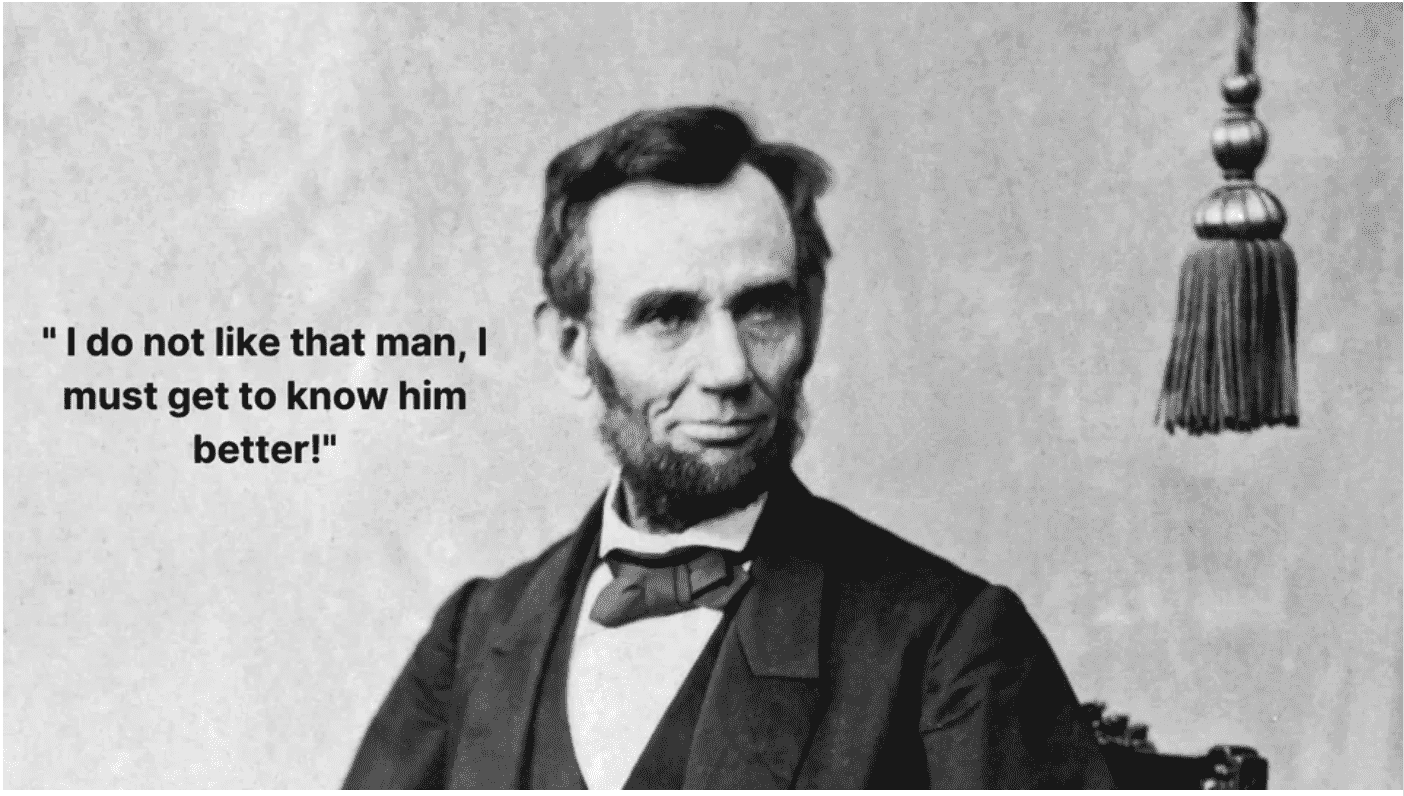
 It’s Abraham Lincoln’s birthday today and I came across this profound statement: “I do not like that man, I must get to know him better.” I love this idea and the reminder that curiosity is a discipline that we need to use, even when we are working with people we don’t initially like.
It’s Abraham Lincoln’s birthday today and I came across this profound statement: “I do not like that man, I must get to know him better.” I love this idea and the reminder that curiosity is a discipline that we need to use, even when we are working with people we don’t initially like.
I just conducted a string of Close-out/Lessons Learned partnering sessions and was inspired to share the key lessons the team’s learned related to relationship building. At a high level the Partnering process helps teams set up a project for success by understanding the “why,” or the mission of a project. They declare clear goals in order to achieve that mission, and they establish partnering commitments and an issue resolution ladder to help ensure that they will prioritize relationships over any specific project issue.
The fact is that not every project has great relationships from the jump. On one side of the bell curve, you can capture a team where everything gels and the teamwork just falls into place. And on the other side of the bell curve, it’s a struggle and it’s like the team falls into a pit and just keeps stumbling. Happily, for the vast majority of teams, with a little intentional focus and work, you can cultivate relationships and build your teamwork and trust as you move along.
Here are four tips I’ve seen teams do to help ensure you will start aligned, stay aligned, and reach your destination together.
- Align the Leaders
- Structure Time to Build your Relationship
- Measure Progress
- Request Feedback
- Align the Leaders – On one project, the scope wasn’t fully developed, but the mission was clear. The team needed to build the project because it was going to be a landmark and cornerstone for a major event. By having the Department Head for the client team, the Leader of each Division, as well as the President of the contractor in the Partnering kick-off session, the team could hear the mission, receive support for that mission, and also had full confidence they could elevate issues to get them resolved. The team had several risks related to procurement, so each leader offered to help reach out to key materials suppliers as needed, which made what felt impossible, much more achievable.
 Structure Time to Build your Relationship – The second project was a large, complex, and high stakes facility that was not familiar to the owner. As the team progressed through the project, the team noted that there were several unresolved issues that needed a solution in order to maintain momentum (due in part to their magnitude and their complexity). The Executive team committed to monthly job walks with a semi-structured agenda so they could provide updates on outstanding issues and discuss items that were coming in the future. These walks were instrumental in this leadership team building a better relationship and ensuring that they “knew each other better” by the end of the project. This leadership team championed the full closure of a street to facilitate a safer construction site and resolved millions of dollars of issues in a trusting environment. Much of the trust was developed by investing time together.
Structure Time to Build your Relationship – The second project was a large, complex, and high stakes facility that was not familiar to the owner. As the team progressed through the project, the team noted that there were several unresolved issues that needed a solution in order to maintain momentum (due in part to their magnitude and their complexity). The Executive team committed to monthly job walks with a semi-structured agenda so they could provide updates on outstanding issues and discuss items that were coming in the future. These walks were instrumental in this leadership team building a better relationship and ensuring that they “knew each other better” by the end of the project. This leadership team championed the full closure of a street to facilitate a safer construction site and resolved millions of dollars of issues in a trusting environment. Much of the trust was developed by investing time together.- Measure Progress– The teams each used various levels of structure to ensure they made progress on construction issues. The larger projects used the Construction Scorecards to monitor momentum and hold themselves accountable to keep the goals alive. For the smaller projects, they added the goals to their weekly progress meeting minutes, so the mission remained clear. Managing a project is about helping a team achieve the goal, while recognizing that your initial plan will need to be amended regularly. I acknowledge that there are many ways to measure progress, but offering a survey or, at minimum, soliciting feedback from your team about the goals on a regular basis will help you achieve the goal!
- Request Feedback– As I stated at the beginning, to me an effective way to enhance a relationship is to get very curious when conflict arises. If you are feeling resistance, as a leader you want to invest time to understand where the resistance comes from. Sometimes its misalignment of expectations and sometimes the team is just not listening to each other’s needs effectively. When project leaders request feedback and adjust, it highlights to the broader team they can and should do the same. In one of the projects, the owner entity would often start discussions by talking about where they need to improve. When the owner’s team is vulnerable like this, it opens the door for the entire team to be open to looking at how they can foster improvement.
I’ve heard it said many times… at the end of the day, construction is a relationship business. Be intentional about how you set up your relationships with your clients, your teams, and your trade partners and you will get better outcomes. I hope you can join me in celebrating Lincoln’s birthday and think about how you can apply one or more of these tips to your next project.
– Rob
The IPI Partnered Project of the Year Award Applications are now available on the Awards page or download the Microsoft Word version by clicking here. Application deadline is this Wednesday, February 14, 2023.
Rob Reaugh is President of OrgMetrics LLC. He facilitates the City and County of San Francisco Collaborative Partnering Steering Committee and currently works with San Francisco International Airport, San Jose International Airport, BART, Caltrans, and others. He holds a Masters’ Degree in Alternative Dispute Resolution.
For more information please contact Rob Reaugh, RobReaugh@Orgmet.com / (925) 487-2404 (cell), or OrgMetrics, (925) 449-8300.


 Structure Time to Build your Relationship – The second project was a large, complex, and high stakes facility that was not familiar to the owner. As the team progressed through the project, the team noted that there were several unresolved issues that needed a solution in order to maintain momentum (due in part to their magnitude and their complexity). The Executive team committed to monthly job walks with a semi-structured agenda so they could provide updates on outstanding issues and discuss items that were coming in the future. These walks were instrumental in this leadership team building a better relationship and ensuring that they “knew each other better” by the end of the project. This leadership team championed the full closure of a street to facilitate a safer construction site and resolved millions of dollars of issues in a trusting environment. Much of the trust was developed by investing time together.
Structure Time to Build your Relationship – The second project was a large, complex, and high stakes facility that was not familiar to the owner. As the team progressed through the project, the team noted that there were several unresolved issues that needed a solution in order to maintain momentum (due in part to their magnitude and their complexity). The Executive team committed to monthly job walks with a semi-structured agenda so they could provide updates on outstanding issues and discuss items that were coming in the future. These walks were instrumental in this leadership team building a better relationship and ensuring that they “knew each other better” by the end of the project. This leadership team championed the full closure of a street to facilitate a safer construction site and resolved millions of dollars of issues in a trusting environment. Much of the trust was developed by investing time together. Rob Reaugh is President of OrgMetrics LLC. He facilitates the City and County of San Francisco Collaborative Partnering Steering Committee and currently works with San Francisco International Airport, San Jose International Airport, BART, Caltrans, and others. He holds a Masters’ Degree in Alternative Dispute Resolution.
Rob Reaugh is President of OrgMetrics LLC. He facilitates the City and County of San Francisco Collaborative Partnering Steering Committee and currently works with San Francisco International Airport, San Jose International Airport, BART, Caltrans, and others. He holds a Masters’ Degree in Alternative Dispute Resolution.